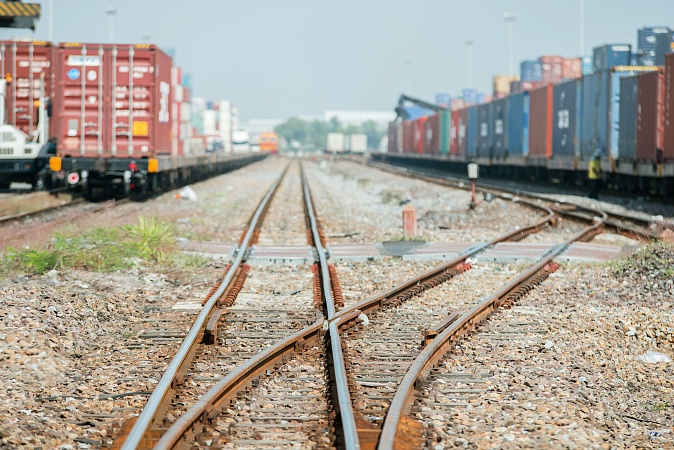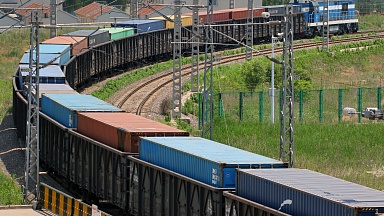Prohibitive air and soaring ocean spot freight rates and a lack of containers available for loading in China that have added to costs and transit time uncertainties have led Asia-Europe shippers to switch to rail freight services in ever greater numbers ahead of Chinese New Year factory closures from 12 February onwards, according to leading forwarders.
The surge this year builds upon strong and growing demand for Asia-Europe rail freight capacity that increased progressively last year and accelerated in the final quarter, as cargo owners and their logistics providers sought more reliable and stable alternatives to congestion, rollovers, and spiralling costs of ocean freight transport — which had eroded the normally substantial price differential between Asia-Europe ocean versus rail transport.
However, demand has surged further this year, despite strongly rising costs for the increasingly tight rail freight capacity, along with border delays on some routes creating backlogs and adding to supply chain logjams.
Onno Boots, regional president and CEO for Asia Pacific at forwarding group Geodis, told Lloyd’s Loading List that growth across all modes had been «phenomenal» in January as demand on the Asia-Europe trade lane peaked ahead of Chinese New Year.
Boots said that rail services from Asia into Europe were currently «a highly competitive proposition as an alternative to ocean transit times», especially given the lack of available containers for loading in China, which was adding to costs and delays to ocean freight.
Surge in volume
«We’ve seen a surge in volume yet again (in 2021) for our rail product, partly driven by conversion from ocean freight,» he said. «Rail has consistently doubled in turnover (annually) during the last four years. I expect 2021 to be no different.»
Average spot ocean shipping freight prices from Asia-Europe on the Shanghai-Rotterdam and Shanghai-Genoa container shipping lanes are up 327% and 227% year-on-year, according to the latest World Container Index assessed by Drewry. Shippers report being quoted figures far in excess of $10,000 per FEU for a guaranteed container and delivery time, making rail alternatives more competitive — despite reports of steeply rising costs for Asia-Europe rail freight in the final quarter.
Lack of space and soaring prices on scheduled container services to Europe from Asia had even prompted Geodis to charter its own vessel which, Boots said, had seen «swift uptake».
He added: «Ocean freight rates have been increasing since September and air freight rates even earlier than that due to the pandemic. We estimate that the switch from ocean to rail freight to be (equivalent to) around 20% to 30% (of the growth in China-Europe rail freight) — given that (China-Europe) rail freight as a mode of shipment for the market was already growing 60% year on year in 2020 as a result of the squeeze in air freight from the movement of PPEs and blank sailings and the lack of containers affecting ocean freight.»
However, Boots said that increased shipments on Asia-Europe rail services at the start of 2021 were also being driven by «the cancellation of blocktrain services in December by the China rail operators or authorities».
Border delays
Border delays are also slowing some rail shipments, according to Zafer Engin, head of value-added services at DHL Global Forwarding China. But the delays on the so-called ‘northern route’ were nothing like the 10 days claimed by one operator of services using a more southerly routing.
Engin told Lloyd’s Loading List that delays at the Polish-Belarusian border were currently negligible but delays at Chinese borders were averaging «2-3 days for Westbound and 1-3 days for Eastbound cargo due to severe winter conditions and new pandemic regulations».
He added: «We are working closely with our partners to ensure as smooth a passage as possible.»
Engin also reported heavy demand for rail options. He said China-Europe rail freight volumes had doubled since the start of Covid-19 outbreaks as shippers sought modal alternatives.
«Demand for rail services is driven by Covid-19 impact on air and ocean freight markets,» he said. «In 2020 air capacity was drastically reduced by passenger flight cancellations that same time have driven air freight costs up. Ocean freight was impacted by pandemic regulations, and transit times have been extended.
Stability of transit times and rates
«Rail freight transit times and rates — with the exception of the last quarter of 2020 year — remained stable, and gave customers more confidence to use this mode of transport.»
Anecdotal reports indicate that China-Europe rail freight rates have roughly doubled in the last few months of 2020, due to the strong demand from shippers forced out of the air and ocean markets by tight capacity and equipment shortages. But demand for China-Europe rail freight services has remained strong, while some reports indicate that China-Europe ocean freight rates have even surpassed prices for some China-Europe rail freight services since October, despite the rising rail freight costs.
A source close to one freight forwarder told Lloyd’s Loading List that those higher China-Europe rail costs had made the profitability of China-Europe rail services more marginal for forwarders, whereas it had previously been a very high-margin business for European logistics providers.
Structural changes
Nevertheless, another factor favouring rail freight has been structural changes in the China-Europe trade, in particular the large amounts of PPE equipment that has been shipped by both companies and governments. «There were whole block trains dispatched from China to Europe carrying only PPE in 2020,» said Engin.
«Lockdown policies in many European countries have also driven up sales of consumer electronics that helped people to adjust to new home-office reality. Many companies started to use railway, or increased rail freight usage to move such valuable cargo from China to Europe.»
The uptick in demand prompted DHL to start a new ‘fast service’ to Southern Poland via Ukraine last year. «This connection uses wide gauge railway tracks from China-Kazakhstan border directly to Slawkow in Poland,» said Engin.
«This terminal is located conveniently for customers in Central and Eastern Europe. Furthermore, we have signed Memorandum of Understanding with Ukrainian Railways and Center of Transport Liski, to drive rail connectivity between China and Ukraine, and ultimately to also facilitate trade between the other European and Asian markets via China and Ukraine.»
Engins said DHL was also «actively looking at new lanes and thinking how we can reduce transit times yet maintain or increase carbon efficiency compared to air freight».



